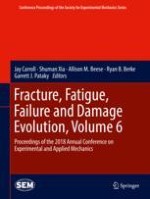2019 | Buch
Fracture, Fatigue, Failure and Damage Evolution, Volume 6
Proceedings of the 2018 Annual Conference on Experimental and Applied Mechanics
herausgegeben von: Dr. Jay Carroll, Dr. Shuman Xia, Dr. Allison M. Beese, Dr. Ryan B. Berke, Dr. Garrett J. Pataky
Verlag: Springer International Publishing
Buchreihe : Conference Proceedings of the Society for Experimental Mechanics Series
